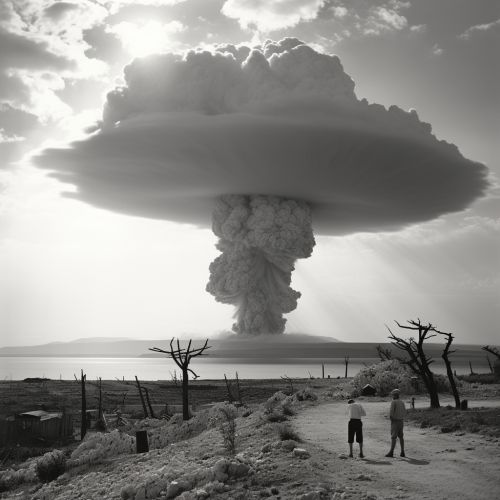Nuclear weapons
Introduction
Nuclear weapons are explosive devices that derive their destructive force from nuclear reactions, either fission (fission bombs) or from a combination of fission and fusion reactions (thermonuclear bombs). Both reactions release vast quantities of energy from relatively small amounts of matter. The first test of a fission ("atomic") bomb released an amount of energy approximately equal to 20,000 tons of TNT. The first thermonuclear ("hydrogen") bomb test released energy approximately equal to 10 million tons of TNT.


History
The development of nuclear weapons was initiated by concerns during World War II that Nazi Germany was investigating the applications of nuclear fission for military use. This led to the formation of the Manhattan Project, a U.S. research project to develop atomic weapons. The project successfully developed and tested a fission bomb in 1945. Later that year, two fission bombs were used in combat against the cities of Hiroshima and Nagasaki in Japan.
In the years following World War II, several countries embarked on programs to develop nuclear weapons. These nations include the Soviet Union (now Russia), the United Kingdom, France, China, India, Pakistan, Israel, and North Korea. South Africa also developed nuclear weapons but dismantled its program in 1991.
Design and Function
The design of nuclear weapons is complex and requires a deep understanding of various scientific and engineering principles. The basic principle involves initiating a nuclear reaction that releases a large amount of energy in the form of an explosion.
In a fission bomb, a mass of fissile material (such as uranium-235 or plutonium-239) is assembled into a supercritical mass—the amount of material needed to start an exponentially growing nuclear chain reaction—either by shooting one piece of sub-critical material into another (the "gun" method) or by compressing a sub-critical sphere of material using chemical explosives to many times its original density (the "implosion" method).
A thermonuclear weapon, or hydrogen bomb, uses a fission bomb as a first stage to compress and ignite a second stage of one or more fusion fuels (e.g., deuterium, tritium). The fusion stage can be considerably more powerful than the fission stage, giving thermonuclear weapons a vastly higher destructive power than fission weapons.
Effects of Nuclear Weapons
The destructive force of nuclear weapons is due to a combination of immediate blast effects, thermal radiation, initial nuclear radiation, and residual nuclear radiation or fallout. The energy distribution in these effects varies with the design features of the weapon, particularly the choice of fissile material and whether or not it is a fission or thermonuclear design.
Immediate blast effects are similar to those seen in conventional explosives, but on a much larger scale. Thermal radiation causes skin burns and can start fires at considerable distances. Initial nuclear radiation is intensely lethal close to the explosion, but rapidly decreases in intensity with distance. Residual radiation, or fallout, consists of radioactive materials produced in the explosion, which can cause radiation sickness and contaminate large areas.
Nuclear Strategy and Doctrine
The strategy and doctrine for the use of nuclear weapons vary by country, and have evolved over time. During the Cold War, the United States and the Soviet Union both maintained large arsenals of nuclear weapons and developed strategies for their potential use in warfare. The concept of Mutually Assured Destruction (MAD) emerged as a key element of nuclear strategy during this period. MAD posits that the possession of a large, second-strike capability of nuclear weapons would deter an adversary from launching a first strike, for fear of a retaliatory strike that would result in massive destruction.
Nuclear Proliferation
Nuclear proliferation refers to the spread of nuclear weapons and related technology to nations not recognized as "Nuclear Weapon States" by the Treaty on the Non-Proliferation of Nuclear Weapons (NPT). The NPT recognizes five nations as nuclear-weapon states: the United States, Russia, the United Kingdom, France, and China. Four other nations are known or believed to possess nuclear weapons: India, Pakistan, North Korea, and Israel.
Disarmament
Nuclear disarmament refers to the act of reducing or eliminating nuclear weapons. It can also include the end state of a nuclear-weapon-free world, in which nuclear weapons are completely eliminated. The term denuclearization is also used to describe the return of a nuclear-weapon state to non-nuclear-weapon status. Disarmament is often negotiated in an international context, such as the NPT or the Treaty on the Prohibition of Nuclear Weapons.
